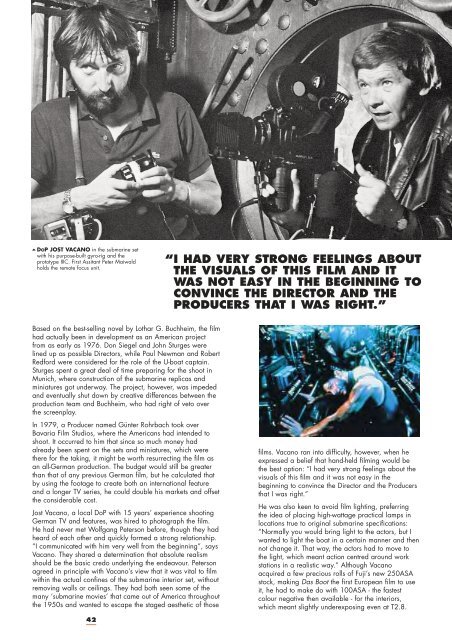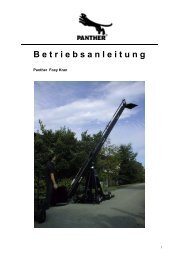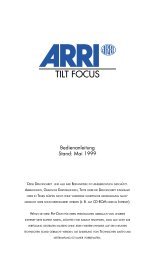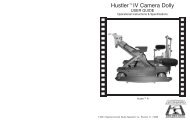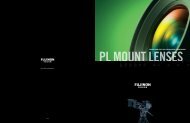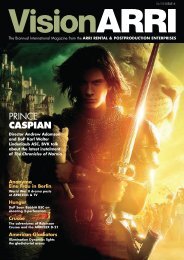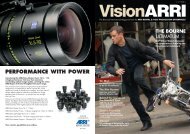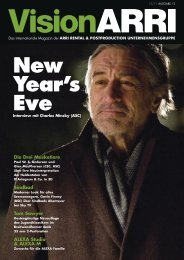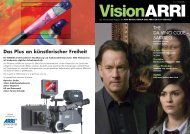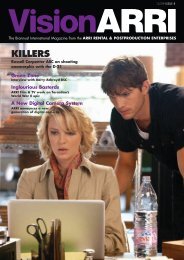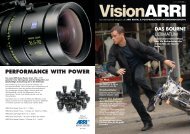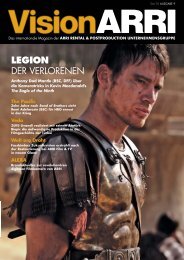Download English (PDF, 1.93MB) - ARRI Group
Download English (PDF, 1.93MB) - ARRI Group
Download English (PDF, 1.93MB) - ARRI Group
You also want an ePaper? Increase the reach of your titles
YUMPU automatically turns print PDFs into web optimized ePapers that Google loves.
�DOP JOST VACANO in the submarine set<br />
with his purpose-built gyro-rig and the<br />
prototype IIIC. First Assitant Peter Maiwald<br />
holds the remote focus unit.<br />
Based on the best-selling novel by Lothar G. Buchheim, the film<br />
had actually been in development as an American project<br />
from as early as 1976. Don Siegel and John Sturges were<br />
lined up as possible Directors, while Paul Newman and Robert<br />
Redford were considered for the role of the U-boat captain.<br />
Sturges spent a great deal of time preparing for the shoot in<br />
Munich, where construction of the submarine replicas and<br />
miniatures got underway. The project, however, was impeded<br />
and eventually shut down by creative differences between the<br />
production team and Buchheim, who had right of veto over<br />
the screenplay.<br />
In 1979, a Producer named Günter Rohrbach took over<br />
Bavaria Film Studios, where the Americans had intended to<br />
shoot. It occurred to him that since so much money had<br />
already been spent on the sets and miniatures, which were<br />
there for the taking, it might be worth resurrecting the film as<br />
an all-German production. The budget would still be greater<br />
than that of any previous German film, but he calculated that<br />
by using the footage to create both an international feature<br />
and a longer TV series, he could double his markets and offset<br />
the considerable cost.<br />
Jost Vacano, a local DoP with 15 years’ experience shooting<br />
German TV and features, was hired to photograph the film.<br />
He had never met Wolfgang Peterson before, though they had<br />
heard of each other and quickly formed a strong relationship.<br />
“I communicated with him very well from the beginning”, says<br />
Vacano. They shared a determination that absolute realism<br />
should be the basic credo underlying the endeavour. Peterson<br />
agreed in principle with Vacano’s view that it was vital to film<br />
within the actual confines of the submarine interior set, without<br />
removing walls or ceilings. They had both seen some of the<br />
many ‘submarine movies’ that came out of America throughout<br />
the 1950s and wanted to escape the staged aesthetic of those<br />
42<br />
“I HAD VERY STRONG FEELINGS ABOUT<br />
THE VISUALS OF THIS FILM AND IT<br />
WAS NOT EASY IN THE BEGINNING TO<br />
CONVINCE THE DIRECTOR AND THE<br />
PRODUCERS THAT I WAS RIGHT.”<br />
films. Vacano ran into difficulty, however, when he<br />
expressed a belief that hand-held filming would be<br />
the best option: “I had very strong feelings about the<br />
visuals of this film and it was not easy in the<br />
beginning to convince the Director and the Producers<br />
that I was right.”<br />
He was also keen to avoid film lighting, preferring<br />
the idea of placing high-wattage practical lamps in<br />
locations true to original submarine specifications:<br />
“Normally you would bring light to the actors, but I<br />
wanted to light the boat in a certain manner and then<br />
not change it. That way, the actors had to move to<br />
the light, which meant action centred around work<br />
stations in a realistic way.” Although Vacano<br />
acquired a few precious rolls of Fuji’s new 250ASA<br />
stock, making Das Boot the first European film to use<br />
it, he had to make do with 100ASA - the fastest<br />
colour negative then available - for the interiors,<br />
which meant slightly underexposing even at T2.8.


